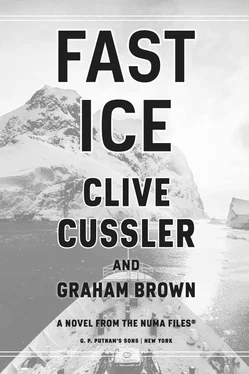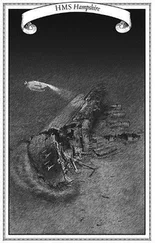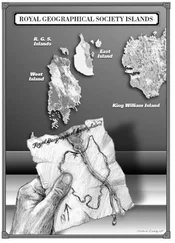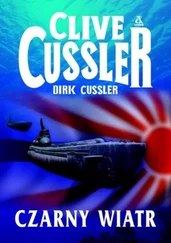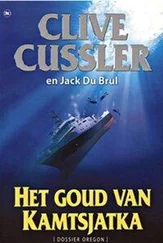“They started off straight,” Kurt pointed out, “curving as the list grew worse. It means the ship took on water very slowly.”
“We need to be careful,” Joe said. “With that much ice on the superstructure, it’s going to be top-heavy.”
Kurt understood. Ice-covered ships could capsize suddenly even when otherwise seaworthy. “If she weren’t sitting so low in the water, I think she’d have rolled over already. The flooded compartments must be acting as ballast.”
“Probably,” Joe said. “And that iceberg she’s attached herself to might be acting like a float. If that thing breaks free, we could be upside down in the blink of an eye.”
A brief swirl of wind came up, causing the ship to creak and groan. A sound like breaking glass came from somewhere amidships as several dagger-shaped icicles broke loose and crashed to the deck.
“We should be careful when we walk under these things,” Joe said.
“Or over things,” Kurt said. He’d stopped at what appeared to be a mound of snow. Closer inspection revealed a body frozen to the deck. Frost and ice had covered the man’s features. Brushing away revealed the gray skin of his face and a circular swath of red staining the jacket he wore.
“Blood,” Joe said. “The bright color suggests it froze before it coagulated.”
“He’s been shot in the back,” Kurt said grimly. “I wasn’t expecting survivors, but this is a bad sign. Let’s make our way inside.”
They moved across the deck, pausing beside the Grishka ’s helicopter.
The craft had frost on the windshield and some ice on its sheet metal, but the rotor blades and engine compartment were protected by weatherproof covers and those covers were clean and ice-free.
“Electrical lines,” Joe said, pointing to cables coming from the bulkhead to the helicopter. “The covers are heated. Like our jackets.”
“That explains the infrared signature that the satellite detected,” Kurt replied. “As long as the solar panels haven’t frozen over, there should be enough juice running through it.”
“Makes you wonder why no one used it to get off the ship?”
“Probably never got the chance,” Kurt said.
Joe made his way over to the helicopter and scraped the frost off the curved windshield. The interior was dark and empty.
“Let’s see how the rest of the ship looks,” Kurt said. “The engine room is probably flooded and useless, but there might be an auxiliary power unit we can fire up.”
Leaving the helicopter behind, they crossed the deck to the nearest hatchway. Like everything else on the ship, it was locked in position by an accumulation of frozen water.
Kurt pulled hard and, when that didn’t work, slammed a shoulder into the door to break the ice free. After kicking a few stray pieces away, he pulled back using both hands. It moved halfway before jamming up again. The gap was just wide enough for them to squeeze through.
“Age before beauty,” Joe, deferring to Kurt, suggested.
“You’re six months younger than me,” Kurt pointed out.
“But twenty-seven percent more attractive,” Joe insisted.
Kurt laughed and slipped through the door. “We really need to work on your math.”
The tilted corridor was cluttered and dank. Light coming through the open hatchway revealed walls coated white from moisture getting inside and freezing. Farther on, a drab avocado green paint scheme revealed itself. The dingy layer of paint was peeling in places and long overdue for a touch-up.
With his eyes slowly adjusting to the darkened corridor, Kurt reached toward a tab on his collar, clicking the button he found there. The LEDs on his jacket lit instantly to full brightness, providing a wide swath of light across the interior of the passageway.
Stepping up beside him, Joe switched his lights on as well. Between the two of them, the hallway was now lit as if by one powerful floodlight. It showed the carnage had not been limited to the outside.
They found nine bodies in the aft section of the deck. Each of them shot multiple times. A quick search of the crew quarters revealed five sailors shot in their beds at close range.
“Whoever hit this ship, they came on hard and fast,” Joe said.
“This was a one-sided battle,” Kurt replied. “These people never had a chance.”
They continued the search without any expectation of finding survivors. They did find additional bodies in the stairwell and two more on the bridge. Heading belowdecks, they came to the science center and recognized immediately that something was amiss.
Drawers and file cabinets had been left open and emptied. A tangled web of power cords and USB cables lined one desk, but the computers and laptops they might have once linked up to were nowhere to be seen. Two keyboards and a stray mouse pad randomly tossed to one side told the rest of the story.
“This place has been ransacked,” Kurt said.
Searching for anything that had been left behind, Kurt found a few random sheets of paper tucked down behind the printer.
“Anything interesting?” Joe asked.
Kurt leafed through the stack. One sheet was directions for rebooting the cooling system, several others proved to be scheduling sheets. The only thing of any interest was a black and white photo that had been printed on regular copy paper.
The image showed several men standing in the snow. They wore heavy boots and cold-weather gear of vintage style. Someone had drawn on the photo with red ink, adding horns on the top of one man’s head. A Hitler mustache had been hastily applied to the face of another. A plaque in front of them read Deutsche Antarktische Expedition 1938–1939. Draped beneath it was the unmistakable banner of Nazi Germany.
Kurt handed Joe the photo.
“Well, that’s unexpected,” Joe said.
Kurt nodded, shuffling through the rest of the scraps. He found nothing to explain the photo or the graffiti that had been scrawled on it. Nor did he find anything to suggest what the research team had been working on. Taking the photo back from Joe, he folded it up and slid it into a pocket. “Let’s see what’s next.”
They moved to the adjoining compartment, discovering long, empty racks that ran the length of the room. The racks were stacked like shelves all the way up to the ceiling, but they held nothing.
“Cold-storage room,” Joe said. “These shelves are designed to hold ice cores. We outfitted a NUMA vessel heading to Greenland last summer with a vault like this.”
Kurt touched one of the cradles. It was no colder than the rest of the room. “What happened to the ice?”
“Must have been taken,” Joe said. “Even with the system off-line, that much ice would never melt. Not with the whole ship frozen solid. I think we can safely assume that whoever hit this ship was after what Cora claimed to have found.”
“Speaking of Cora,” Kurt said, “I haven’t seen her yet. We should keep looking.”
He moved forward, heading for the next compartment and stopping beside a console that housed various controls and readouts. Scraping frost off the panel, he found a row of LEDs blinking a dim orange color. “This is the control system for the cryogenic unit,” he said. “It’s still functioning.”
“Must be getting juice from the solar array,” Joe said. “Like the helicopter’s de-icing system.”
“Makes sense,” Kurt replied. “But if the cryogenic unit is still on, why is this room the same temperature as the rest of the ship?”
Kurt looked around for an answer to his own question. His gaze settled on a bundle of insulated hoses. Instead of connecting to the storage racks, the lines ran from the side of the cooling unit, along the floor of the compartment and down a scuttle to the deck below.
Читать дальше
